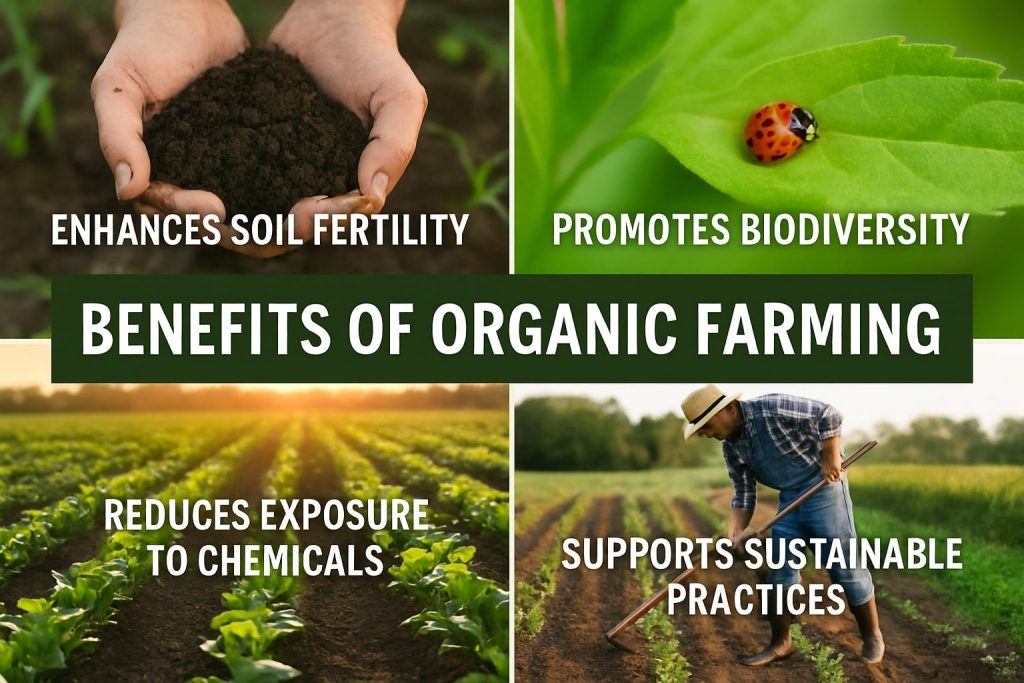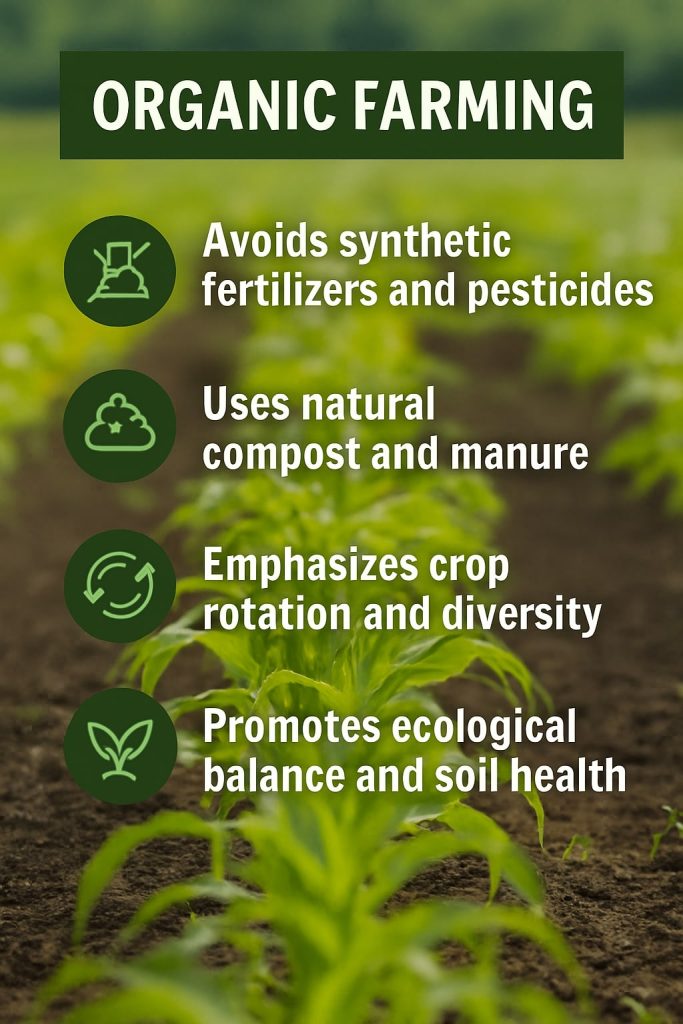Discover the Incredible Impact of Organic Farming on Health and Environment
What is Organic Farming?
Organic farming is a method of farming that nurtures the health of the soil, ecosystem, and people by relying on natural cycles and inputs. It promotes:
– Composting and green manuring for soil enrichment
– Crop rotation and intercropping to prevent soil exhaustion
– Use of organic fertilizers like farmyard manure and vermicompost
– Biopesticides and natural predators to manage pests
– Prohibition of GMOs, synthetic chemicals, and artificial growth hormones
What Are the Four Types of Organic Farming?
There are various methods under the umbrella of organic farming, each suited to different environments and philosophies:
1. Pure -Only natural inputs; no chemical use at all.
2. Integrated – Combines organic methods with modern tools for efficiency.
3. Biodynamic Farming – Treats the farm as a living system, often following lunar cycles.
4. Natural Farming – Minimal interference; no tilling, weeding, or even fertilizers.
What Are the 4 Principles of Organic Farming?
The four guiding principles of are:
1. Health – Sustain the health of soil, animals, and humans.
2. Ecology – Embrace ecological balance and biodiversity.
3. Fairness – Promote equity among people and animals.
4. Care – Apply responsible farming for future generations.
Post-Harvest Management and Value Addition in Organic Farming
Post-harvest management in organic farming focuses on preserving the natural quality of crops through careful handling, cleaning, grading, and eco-friendly storage methods. By minimizing losses, farmers can maintain freshness and nutritional value. Value addition, such as turning fruits into organic juices or cereals into ready-to-cook mixes, enhances market appeal and profitability.
Learn more about sustainable post-harvest practices and value addition techniques
What is the Biggest Problem for Organic Farmers?
One of the biggest problems faced by organic farmers is effective pest and disease management without the use of chemical pesticides. This often leads to reduced crop yields and economic loss. In addition, organic farmers face market competition from cheaper conventionally grown produce, difficulty in accessing certified organic markets, and a lack of infrastructure for organic inputs and distribution. These challenges make it essential for organic farmers to innovate and collaborate to maintain profitability and sustainability.
What Are the 10 Benefits of Organic Farming?
offers significant advantages:
1. Enhances Soil Health
2. Reduces Environmental Pollution
3. Conserves Water
4. Boosts Biodiversity
5. Reduces Carbon Footprint
6. Produces Chemical-Free Food
7. Improves Nutritional Value
8. Empowers Small Farmers
9. Promotes Animal Welfare
10. Builds Climate Resilience

What Methods Are Used in Organic Farming?
The employs a wide range of eco-friendly methods to grow crops and raise livestock. Key practices include crop rotation to prevent soil depletion, green manuring to enhance fertility, composting organic waste, and using natural pest control like neem oil and beneficial insects. Intercropping and mulching are also used to improve biodiversity and moisture retention. Livestock in organic systems are fed organic feed and are not given growth hormones or antibiotics.Common methods include:
– Crop Rotation
– Composting
– Green Manuring
– Mulching
– Biological Pest Control
– Intercropping
Which Crop is Best for Organic Farming?
Several crops adapt well to farming practices. Among the best are pulses such as lentils and chickpeas, cereals like rice and wheat, oilseeds including mustard and sunflower, and vegetables such as tomatoes, spinach, and carrots. Fruits like bananas and papayas also thrive under organic cultivation. The choice of crop largely depends on regional climate, soil health, market demand, and farming experience.Curious about how chemical-free agriculture supports a healthier planet and better nutrition? Discover how sustainable techniques, natural composting, and soil-friendly practices are reshaping the future of oraganic farming in India.
Which Are the Two Main Types of Farming?
Farming practices are broadly classified into:
1. Subsistence Farming: Small-scale, traditional methods for family use.
2. Commercial Farming: Large-scale, market-oriented farming with modern tools.
What is Advantage and Its Disadvantages?
While farming offers numerous environmental and health benefits, it comes with certain challenges:
– Lower Yields: Organic crops often yield 20–30% less than conventional crops.
– Labor Intensive: Manual weeding, composting, and pest control increase labor requirements.
– High Input Costs: Organic-certified seeds, compost, and certification can be expensive.
– Market Limitations: Limited access to organic markets and supply chains in some regions.
– Pest Vulnerability: Without synthetic pesticides, crops can be more prone to infestations.
How Much Land is Required for Organic Farming?
There is no strict minimum land requirement to start farming it can be practiced on a small backyard plot or on hundreds of acres. However, for commercial viability and sustained income, having at least 2 to 5 acres of cultivable land is recommended. The key to success lies not in land size but in careful planning, diversification, and organic certification to access premium markets.

Which State is 100% Organic Farming?
Sikkim became India’s and the world’s first 100% organic state in 2016. This means that all agricultural land in the state is cultivated without synthetic fertilizers or pesticides. The initiative involved converting over 75,000 hectares into certified organic farmland, empowering thousands of farmers with training, organic inputs, and access to markets. Sikkim stands as a global model for sustainable agriculture and ecological governance.
Main Characteristics of Chemical-Free and Eco-Friendly Cultivation
One of the most defining features of natural cultivation practices is the complete avoidance of synthetic chemicals. Instead of relying on artificial fertilizers or harmful pesticides, these systems emphasize the use of organic compost, green manure, crop residues, and bio-fertilizers to nourish the soil. This approach not only protects the health of the environment but also maintains the nutritional quality of the produce.
Soil is treated as a living ecosystem—its health is central to everything. Practices like crop rotation, cover cropping, and the application of organic matter help maintain soil structure and fertility. These methods boost microbial life, which plays a vital role in breaking down nutrients for plant uptake, resulting in healthier growth without synthetic support.
Another core characteristic is the reliance on natural pest and disease management systems. Farmers avoid chemical insecticides, opting instead for solutions such as neem extracts, biological predators, pheromone traps, and intercropping to control harmful insects and pathogens. These strategies promote ecological balance and minimize harm to non-target species like bees and butterflies.
Diversity is also a fundamental principle. Rather than monoculture fields, these farms often grow multiple crops together, which supports biodiversity, improves soil health, and reduces the risk of crop failure due to pests or disease outbreaks. Crop diversity also plays a crucial role in preserving genetic variety and enhancing resilience to climate changes.
Animal husbandry under these practices prioritizes animal welfare. Livestock are raised in humane conditions with access to natural grazing, clean water, and chemical-free feed. They are not given growth hormones or routine antibiotics. Instead, their health is maintained through herbal remedies, balanced diets, and adequate space to exhibit natural behavior.
